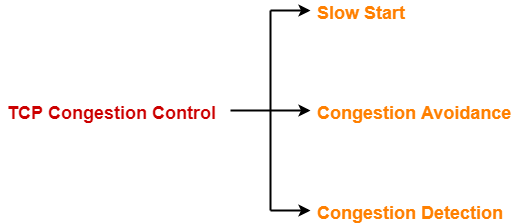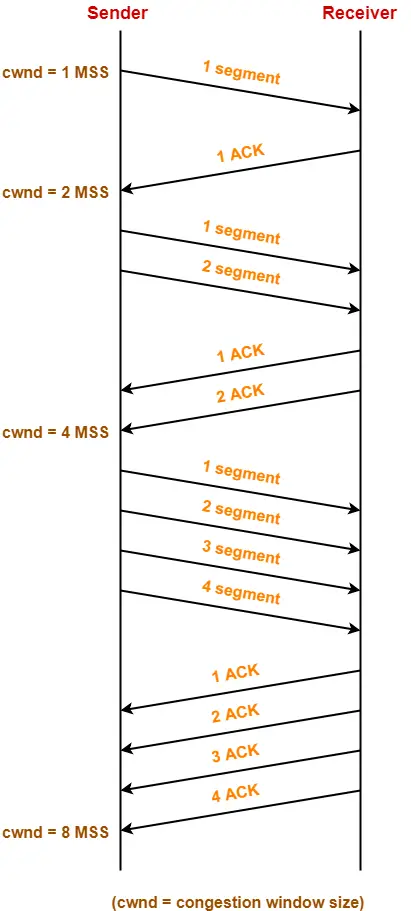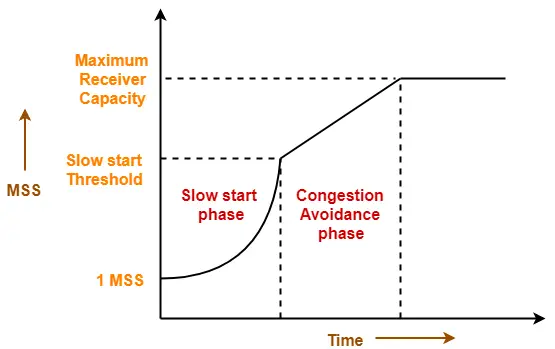TCP Congestion Control-
Before you go through this article, make sure that you have gone through the previous article on TCP Congestion Control.
TCP congestion control policy consists of following three phases-

- Slow Start
- Congestion Avoidance
- Congestion Detection
In this article, we will discuss practice problems on TCP Congestion Control.
PRACTICE PROBLEMS BASED ON TCP CONGESTION CONTROL-
Problem-01:
The growth of congestion window takes place-
- Infinitely
- Up to Threshold
- Up to the size of receiver’s window
- Up to timeout
Solution-
Option (C) is correct.
Problem-02:
Consider the effect of using slow start on a line with a 10 msec RTT and no congestion. The receiver window is 24 KB and the maximum segment size is 2 KB. How long does it take before the first full window can be sent?
Solution-
Given-
- Receiver window size = 24 KB
- Maximum Segment Size = 2 KB
- RTT = 10 msec
Receiver Window Size-
Receiver window size in terms of MSS
= Receiver window size / Size of 1 MSS
= 24 KB / 2 KB
= 12 MSS
Slow Start Threshold-
Slow start Threshold
= Receiver window size / 2
= 12 MSS / 2
= 6 MSS
Slow Start Phase-
- Window size at the start of 1st transmission = 1 MSS
- Window size at the start of 2nd transmission = 2 MSS
- Window size at the start of 3rd transmission = 4 MSS
- Window size at the start of 4th transmission = 6 MSS
Since the threshold is reached, so it marks the end of slow start phase.
Now, congestion avoidance phase begins.
Congestion Avoidance Phase-
- Window size at the start of 5th transmission = 7 MSS
- Window size at the start of 6th transmission = 8 MSS
- Window size at the start of 7th transmission = 9 MSS
- Window size at the start of 8th transmission = 10 MSS
- Window size at the start of 9th transmission = 11 MSS
- Window size at the start of 10th transmission = 12 MSS
From here,
- Window size at the end of 9th transmission or at the start of 10th transmission is 12 MSS.
- Thus, 9 RTT’s will be taken before the first full window can be sent.
So,
Time taken before the first full window is sent
= 9 RTT’s
= 9 x 10 msec
= 90 msec
Problem-03:
Consider an instance of TCP’s Additive Increase Multiplicative Decrease (AIMD) algorithm where the window size at the start of slow start phase is 2 MSS and the threshold at the start of first transmission is 8 MSS. Assume that a time out occurs during the fifth transmission. Find the congestion window size at the end of tenth transmission.
- 8 MSS
- 14 MSS
- 7 MSS
- 12 MSS
Solution-
Given-
- Window size at the start of slow start phase = 2 MSS
- Threshold at the start of first transmission = 8 MSS
- Time out occurs during 5th transmission
Slow Start Phase-
- Window size at the start of 1st transmission = 2 MSS
- Window size at the start of 2nd transmission = 4 MSS
- Window size at the start of 3rd transmission = 8 MSS
Since the threshold is reached, so it marks the end of slow start phase.
Now, congestion avoidance phase begins.
Congestion Avoidance Phase-
- Window size at the start of 4th transmission = 9 MSS
- Window size at the start of 5th transmission = 10 MSS
It is given that time out occurs during 5th transmission.
TCP reacts by-
- Setting the slow start threshold to half of the current congestion window size.
- Decreasing the congestion window size to 2 MSS (Given value is used).
- Resuming the slow start phase.
So now,
- Slow start threshold = 10 MSS / 2 = 5 MSS
- Congestion window size = 2 MSS
Slow Start Phase-
- Window size at the start of 6th transmission = 2 MSS
- Window size at the start of 7th transmission = 4 MSS
- Window size at the start of 8th transmission = 5 MSS
Since the threshold is reached, so it marks the end of slow start phase.
Now, congestion avoidance phase begins.
Congestion Avoidance Phase-
- Window size at the start of 9th transmission = 6 MSS
- Window size at the start of 10th transmission = 7 MSS
- Window size at the start of 11th transmission = 8 MSS
From here,
Window size at the end of 10th transmission
= Window size at the start of 11th transmission
= 8 MSS
Thus, Option (A) is correct.
Problem-04:
Suppose that the TCP congestion window is set to 18 KB and a time out occurs. How big will the window be if the next four transmission bursts are all successful? Assume that the MSS is 1 KB.
Solution-
Congestion Window Size-
Congestion window size in terms of MSS
= 18 KB / Size of 1 MSS
= 18 KB / 1 KB
= 18 MSS
Reaction Of TCP On Time Out-
TCP reacts by-
- Setting the slow start threshold to half of the current congestion window size.
- Decreasing the congestion window size to 1 MSS.
- Resuming the slow start phase.
So now,
- Slow start threshold = 18 MSS / 2 = 9 MSS
- Congestion window size = 1 MSS
Slow Start Phase-
- Window size at the start of 1st transmission = 1 MSS
- Window size at the start of 2nd transmission = 2 MSS
- Window size at the start of 3rd transmission = 4 MSS
- Window size at the start of 4th transmission = 8 MSS
- Window size at the start of 5th transmission = 9 MSS
Thus, after 4 successful transmissions, window size will be 9 MSS or 9 KB.
Problem-05:
On a TCP connection, current congestion window size is 4 KB. The window advertised by the receiver is 6 KB. The last byte sent by the sender is 10240 and the last byte acknowledged by the receiver is 8192.
Part-01:
The current window size at the sender is ____.
- 2048 B
- 4096 B
- 6144 B
- 8192 B
Part-02:
The amount of free space in the sender window is ____.
- 2048 B
- 4096 B
- 6144 B
- 8192 B
Solution-
Part-01:
Sender window size
= min (Congestion window size, Receiver window size)
= min(4KB , 6KB)
= 4 KB
= 4096 B
Thus, Option (B) is correct.
Part-02:
Given-
- Last byte acknowledged by the receiver = 8192
- Last byte sent by the sender = 10240
From here,
- It means bytes from 8193 to 10240 are still present in the sender’s window.
- These bytes are waiting for their acknowledgement.
- Total bytes present in sender’s window = 10240 – 8193 + 1 = 2048 bytes.
From here,
Amount of free space in sender’s window currently
= 4096 bytes – 2048 bytes
= 2048 bytes
This indicates that half of the sender’s window is currently empty.
Thus, Option (A) is correct.
Next Article- TCP Timers
Get more notes and other study material of Computer Networks.
Watch video lectures by visiting our YouTube channel LearnVidFun.

